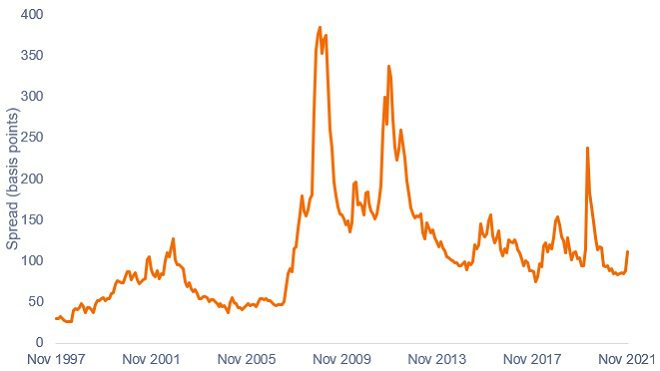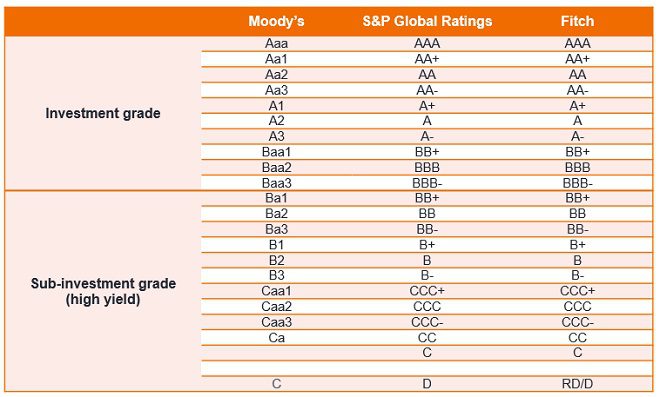Subscribe
Sign up for timely perspectives delivered to your inbox.

Tim Winstone, corporate credit manager, discusses how a cautious and steady approach to steering through 2022 makes sense for both the European Central Bank (ECB) and investors.
The arrival of the omicron variant in Europe reminds us of how quickly the gears can shift in a recovery from the pandemic. Other potential roadblocks on the path to normalisation include, but are not limited to, contagion from risks in China, inflation headwinds and policy error, whether that is tightening financial conditions too late or too early.
These uncertainties come at a time when spreads are at tight levels in the investment grade space, which skews risk to the downside (potential losses). In this scenario, taking on too much beta – or sensitivity to the market – feels akin to hitting a bend in the road at top speed and so will 2022 morph into a test of discipline for investors and central banks? Adopting caution has been the credence of the ECB as its dovish approach to normalising monetary policy puts it behind other major central banks.
The central bank is keeping its exit options open as it acknowledges inflation risks, but also the importance of not overreacting in setting policy until more clarity emerges on how inflation could play out. The uneven, albeit somewhat slowing, recovery in Europe gives further impetus to a gradual withdrawal of easy conditions. Nevertheless, the pandemic emergency purchase programme (PEPP) is set to conclude in March 2022. While this comprises primarily government bond purchases from across the Eurozone, a ripple effect to the credit market through investor perception of risks is possible. Nevertheless, corporate asset purchases are set to continue through the €307 billion corporate sector purchase programme (CSPP)1 programme.
This makes the ECB a significant buyer – in fact around a fifth of the European investment grade market2. We are expecting bond supply to continue with central bank purchases soaking up a decent amount of this. So, while the ECB will take a back seat in 2022, it may still be a driving force behind markets.
The strong technical environment in corporate credit has created one of the key draws to investing in European investment grade. As the ECB’s foot comes off the accelerator, it will probably affect the asset class and spreads. Given it is already a hard road to circumnavigate in the hunt for value, finding opportunities with adequate reward to compensate for risks is the ultimate destination. Positive credit fundamentals, reflected in low default expectations for example, indicate the potential for lower-rated to outperform higher-ranked credit. Spreads have widened recently and while towards the tighter end of the range of the last decade, they are still some way off their lows and remain wider than typical levels seen before the financial crisis. This offers the possibility for some spread compression at the margin, but we need to be realistic that most of the return in 2022 is likely to come from carry.

Source: Bloomberg, ICE BofA Euro Corporate Bond Index, Govt OAS (option-adjusted spread), 30 November 1997 to 30 November 2021.
Changing gear to optimise carry – or the incremental yield benefit gained from holding a bond instead of cash – and capture idiosyncratic risk through individual credit selection, in our view, could help investors navigate 2022 in the search for returns.
While spread compression across different ratings is a possibility, so is the transition of bonds up the rankings. Rising stars – credits that ascend to investment grade status from high yield – were able to emerge from the COVID-induced mire to shine in 2021 as cashflows and earnings recovered. However, there appears to be plenty of fuel left in the tank for more companies to upgrade, as JP Morgan estimates that there is as much US$277 billion of bonds globally that could climb rank by mid-2023 (without another economic shock)3.
One source of returns is from spread narrowing as bonds climb to BBB (investment grade) status. This opportunity is potentially the most attractive in Europe, as the spread differential between BB-rated high yield bonds and BBB cohort is most stark in Europe compared to the UK and the US4.
So, while the environment may get tougher to steer through, a more disciplined approach may be to avoid relying on external factors as the primary driver of upgrades. There are, of course, likely to be beneficiaries from the reopening of economies, particularly after reinstated lockdowns. However, the catalyst for upgrades within investment grade and rising stars to elevate in 2022 could be more neatly tied to individual credit stories – whether that is companies de-levering after financing M&A or changing business structures to create value. Digging deep into the diverse opportunities available in investment grade could identify the less well-researched names to uncover potential alpha opportunities. Beyond issuer selection, looking across a company’s capital structure offers another opportunity to uncover value.
To borrow this term from baseball, it makes sense to us in an environment of risks where markets could easily change direction to seek for small wins that add up over time rather than swing for the fences and get caught out.
1 Source: ECB, as at 26 November.
2 Source: Bloomberg, ECB, Janus Henderson estimates based on published CSPP holdings and size of non-bank senior corporate market per market value of ICE BofA Euro Corporate Indices and assumed eligibility, 26 November 2021.
3 Source: J.P.Morgan, ex emerging market issuers, at 30 September 2021. This figure is a forecast, and there is no guarantee that past trends will continue or that forecasts will be realised.
4 Source: Bloomberg, ICE BofA BBB Euro Corporate Index versus ICE BofA BB Euro High Yield Index; ICE BofA BBB Sterling Corporate Index versus ICE BofA BB Sterling High Yield Index; and ICE BofA BBB US Corporate Index versus ICE BofA BB US High Yield Index, as at 15 November 2021.
Alpha: Alpha is the difference between a portfolio’s return and its benchmark’s return after adjusting for the level of risk taken. A positive alpha suggests that a portfolio has delivered a superior return given the risk taken.
Beta: This measures a portfolio’s (or security’s) relationship with the overall market or any chosen benchmark. The benchmark always has a beta of 1. A portfolio with a beta of 1 means that if the market rises 10%, so should the portfolio. A portfolio with a beta of more than 1 will be expected to move more than the market, but in the same direction. A beta of 0 means the portfolio’s returns are not linked at all to the market returns. A negative beta means the investment should move in the opposite direction to the market.
Credit spread/spread: The difference in yield between securities with similar maturity but different credit quality: e.g., the difference in yield between a high yield corporate bond and a government bond of the same maturity. Widening spreads generally indicate deteriorating creditworthiness of corporate borrowers and narrowing indicates improving creditworthiness.
Deleveraging: A company reducing its borrowing/debt as a proportion of its balance sheet. Within an investment fund, it refers to the fund reducing its level of leverage.
Downside risk: An estimation of how much a security or portfolio may lose if the market moves against it.
High yield bond: A bond that has a lower credit rating than an investment grade bond. Sometimes known as a sub-investment grade bond. These bonds carry a higher risk of the issuer defaulting on their payments, so they are typically issued with a higher coupon to compensate for the additional risk.
Idiosyncratic risk: This is the inherent risk involved in investing in a specific asset, such as a bond or stock.
Investment grade bond: A bond typically issued by governments or companies perceived to have a relatively low risk of defaulting on their payments. The higher quality of these bonds is reflected in their higher credit ratings when compared with bonds thought to have a higher risk of default, such as high yield bonds.
Monetary policy normalisation: The phasing out of central banks’ unconventional monetary policies (zero or low interest rates and purchase of short-term government bonds) that were put in place to stimulate the global economy following the 2008 Global Financial Crisis.
Ratings/credit ratings: A score assigned to a borrower, based on their creditworthiness. It may apply to a government or company, or to one of their individual debts or financial obligations. An entity issuing investment grade bonds would typically have a higher credit rating than one issuing high yield bonds. The rating is usually given by credit rating agencies, such as Standard & Poor’s or Fitch, which use standardised scores such as ‘AAA’ (a high credit rating) or ‘B-‘ (a low credit rating). Moody’s, another well known credit rating agency, uses a slightly different format with Aaa (a high credit rating) and B3 (a low credit rating) as per the table below. The ratings spectrum starts at the top with AAA (highest quality) and progresses down the alphabet to C and D, which indicate a borrower that is vulnerable to defaulting or has defaulted.
